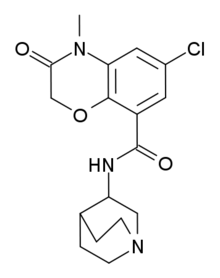Azasetron
Azasetron is an antiemetic which acts as a 5-HT3 receptor antagonist, pKi = 9.27 [1] It is used in the management of nausea and vomiting induced by cancer chemotherapy (such as cisplatin chemotherapy). Azasetron hydrochloride is given in a usual dose of 10 mg once daily by mouth or intravenously. It is approved for marketing in Japan, and marketed exclusively by Torii Pharmaceutical Co., Ltd. under the trade names "Serotone I.V. Injection 10 mg" and "Serotone Tablets 10 mg".[2] Pharmacokinetics data from S. Tsukagoshi.[3]
 | |
| Clinical data | |
|---|---|
| AHFS/Drugs.com | International Drug Names |
| Routes of administration | Oral |
| ATC code |
|
| Pharmacokinetic data | |
| Bioavailability | 90% |
| Excretion | 60-70% |
| Identifiers | |
IUPAC name
| |
| CAS Number | |
| PubChem CID | |
| IUPHAR/BPS | |
| ChemSpider |
|
| UNII | |
| KEGG |
|
| ChEMBL | |
| CompTox Dashboard (EPA) | |
| Chemical and physical data | |
| Formula | C17H20ClN3O3 |
| Molar mass | 349.81 g/mol g·mol−1 |
| 3D model (JSmol) | |
SMILES
| |
InChI
| |
| (verify) | |
References
- "Azasetron". drugcentral.org/. UNM School of Medicine. 2016-07-31. Retrieved 2016-11-11.
- "Torii Pharmaceutical to Solely Market Antiemetic Drugs". Torii Pharmaceutical Co Ltd. 2009-01-13. Archived from the original on 2014-06-13. Retrieved 2016-11-11.
- Tsukagoshi, S. (1999-06-01). "[Pharmacokinetics of azasetron (Serotone), a selective 5-HT3 receptor antagonist]". Gan to Kagaku Ryoho. Cancer & Chemotherapy. 26 (7): 1001–1008. ISSN 0385-0684. PMID 10396331.
This article is issued from
Wikipedia.
The text is licensed under Creative
Commons - Attribution - Sharealike.
Additional terms may apply for the media files.